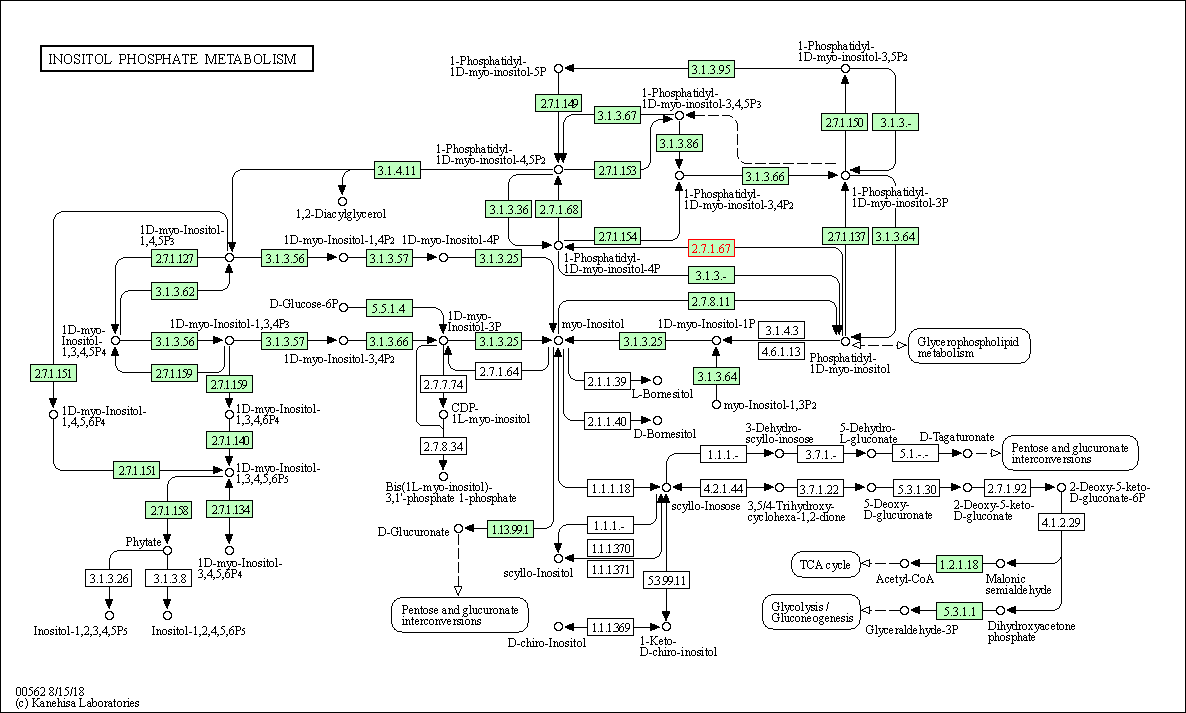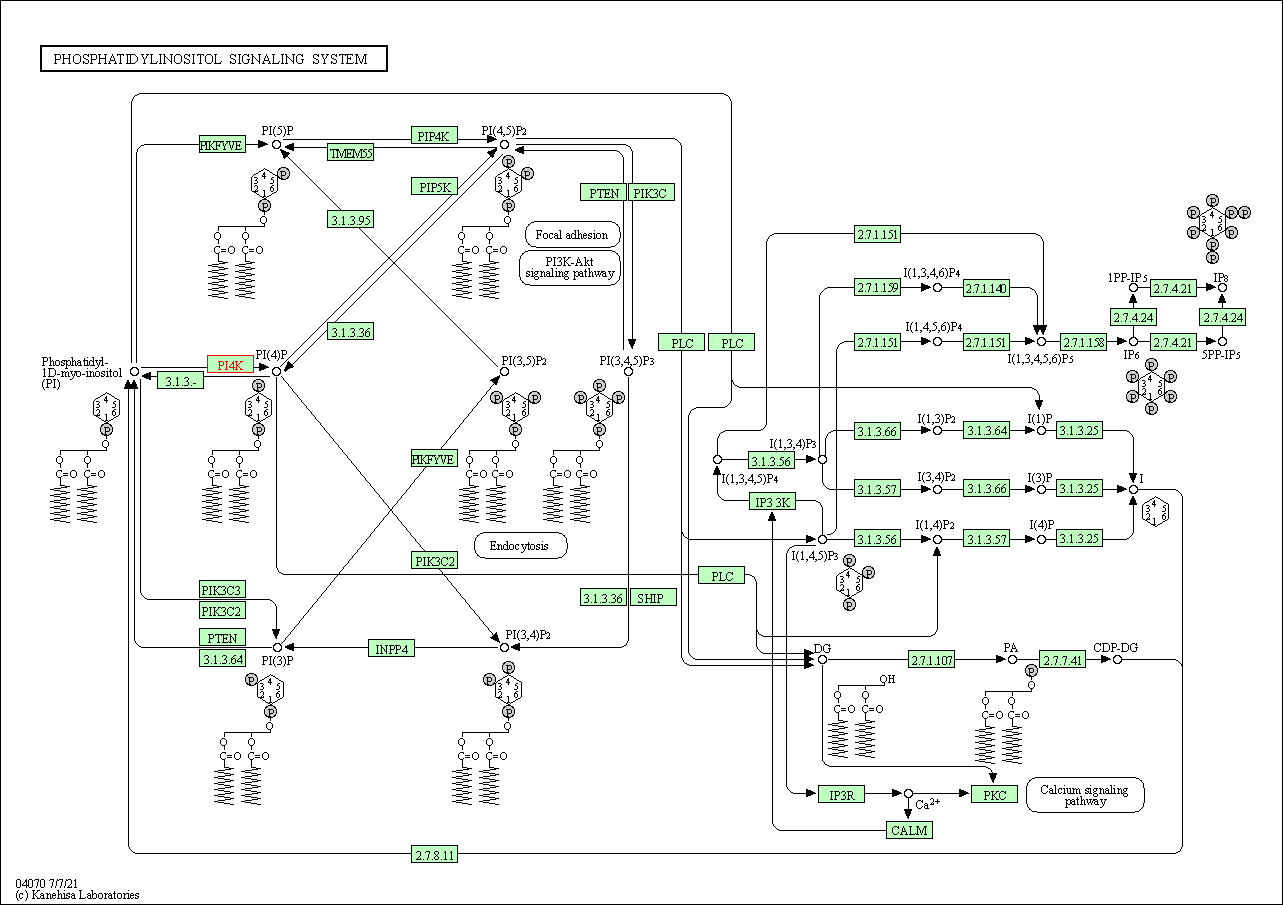Target Information
| Target General Information | Top | |||||
|---|---|---|---|---|---|---|
| Target ID |
T12541
(Former ID: TTDI03461)
|
|||||
| Target Name |
Phosphatidylinositol-4-kinase beta (PI4KB)
|
|||||
| Synonyms |
PtdIns 4-kinase beta; Phosphatidylinositol 4-kinase beta; PIK4CB; PI4Kbeta; PI4K92; PI4K-beta; NPIK
Click to Show/Hide
|
|||||
| Gene Name |
PI4KB
|
|||||
| Target Type |
Clinical trial target
|
[1] | ||||
| Disease | [+] 2 Target-related Diseases | + | ||||
| 1 | Chronic obstructive pulmonary disease [ICD-11: CA22] | |||||
| 2 | Zoonotic viral disease ICD-11: 1D6Y | |||||
| Function |
Phosphorylates phosphatidylinositol (PI) in the first committed step in the production of the second messenger inositol-1,4,5,-trisphosphate (PIP). May regulate Golgi disintegration/reorganization during mitosis, possibly via its phosphorylation. Involved in Golgi-to-plasma membrane trafficking (By similarity).
Click to Show/Hide
|
|||||
| UniProt ID | ||||||
| EC Number |
EC 2.7.1.67
|
|||||
| Sequence |
MGDTVVEPAPLKPTSEPTSGPPGNNGGSLLSVITEGVGELSVIDPEVAQKACQEVLEKVK
LLHGGVAVSSRGTPLELVNGDGVDSEIRCLDDPPAQIREEEDEMGAAVASGTAKGARRRR QNNSAKQSWLLRLFESKLFDISMAISYLYNSKEPGVQAYIGNRLFCFRNEDVDFYLPQLL NMYIHMDEDVGDAIKPYIVHRCRQSINFSLQCALLLGAYSSDMHISTQRHSRGTKLRKLI LSDELKPAHRKRELPSLSPAPDTGLSPSKRTHQRSKSDATASISLSSNLKRTASNPKVEN EDEELSSSTESIDNSFSSPVRLAPEREFIKSLMAIGKRLATLPTKEQKTQRLISELSLLN HKLPARVWLPTAGFDHHVVRVPHTQAVVLNSKDKAPYLIYVEVLECENFDTTSVPARIPE NRIRSTRSVENLPECGITHEQRAGSFSTVPNYDNDDEAWSVDDIGELQVELPEVHTNSCD NISQFSVDSITSQESKEPVFIAAGDIRRRLSEQLAHTPTAFKRDPEDPSAVALKEPWQEK VRRIREGSPYGHLPNWRLLSVIVKCGDDLRQELLAFQVLKQLQSIWEQERVPLWIKPYKI LVISADSGMIEPVVNAVSIHQVKKQSQLSLLDYFLQEHGSYTTEAFLSAQRNFVQSCAGY CLVCYLLQVKDRHNGNILLDAEGHIIHIDFGFILSSSPRNLGFETSAFKLTTEFVDVMGG LDGDMFNYYKMLMLQGLIAARKHMDKVVQIVEIMQQGSQLPCFHGSSTIRNLKERFHMSM TEEQLQLLVEQMVDGSMRSITTKLYDGFQYLTNGIM Click to Show/Hide
|
|||||
| 3D Structure | Click to Show 3D Structure of This Target | PDB | ||||
| Drugs and Modes of Action | Top | |||||
|---|---|---|---|---|---|---|
| Clinical Trial Drug(s) | [+] 1 Clinical Trial Drugs | + | ||||
| 1 | GSK3923868 | Drug Info | Phase 1 | Chronic obstructive pulmonary disease | [2] | |
| Mode of Action | [+] 1 Modes of Action | + | ||||
| Inhibitor | [+] 3 Inhibitor drugs | + | ||||
| 1 | GSK3923868 | Drug Info | [3] | |||
| 2 | GSK3923868 | Drug Info | [4] | |||
| 3 | PIK-93 | Drug Info | [1] | |||
| Cell-based Target Expression Variations | Top | |||||
|---|---|---|---|---|---|---|
| Cell-based Target Expression Variations | ||||||
| Drug Binding Sites of Target | Top | |||||
|---|---|---|---|---|---|---|
| Ligand Name: Adenosine triphosphate | Ligand Info | |||||
| Structure Description | Phosphatidylinositol 4-kinase III beta crystallized with ATP | PDB:4WAE | ||||
| Method | X-ray diffraction | Resolution | 3.32 Å | Mutation | No | [5] |
| PDB Sequence |
LLRLFESKLF
139 DISMAISYLY149 NSKEPGVQAY159 IGNRLFCFRN169 EDVDFYLPQL179 LNMYIHMDED 189 VGDAIKPYIV199 HRCRQSINFS209 LQCALLLGAY219 SSDMNSFSSP319 VRLAPEREFI 329 KSLMAIGKRL339 ATLPTKEQKT349 QRLISELSLL359 NHKLPARVWL369 PTAGFDHHVV 379 RVPHTQAVVL389 NSKDKAPYLI399 YVEVLECENF409 DTTSVPARIP419 EWQEKVRRIR 545 EGSPYGHLPN555 WRLLSVIVKC565 GDDLRQELLA575 FQVLKQLQSI585 WEQERVPLWI 595 KPYKILVISA605 DSGMIEPVVN615 AVSIHQVKKQ625 SQLSLLDYFL635 QEHGSYTTEA 645 FLSAQRNFVQ655 SCAGYCLVCY665 LLQVKDRHNG675 NILLDAEGHI685 IHIDFGFILS 695 SSPRNLGFET705 SAFKLTTEFV715 DVMGGLDGDM725 FNYYKMLMLQ735 GLIAARKHMD 745 KVVQIVEIMQ755 QGSQLPCFHG765 SSTIRNLKER775 FHMSMTEEQL785 QLLVEQMVDG 795 SMR
|
|||||
|
|
||||||
| Ligand Name: PIK-93 | Ligand Info | |||||
| Structure Description | Phosphatidylinositol 4-kinase III beta-PIK93 in a complex with Rab11a- GTP gammaS | PDB:4D0L | ||||
| Method | X-ray diffraction | Resolution | 2.94 Å | Mutation | Yes | [6] |
| PDB Sequence |
SWLLRLFESK
137 LFDISMAISY147 LYNSKEPGVQ157 AYIGNRLFCF167 RNEDVDFYLP177 QLLNMYIHMD 187 EDVGDAIKPY197 IVHRCRQSIN207 FSLQCALLLG217 AYSSRGTKLR237 KLILSRLAPE 310 REFIKSLMAI320 GKRLATLPTK330 EQKTQRLISE340 LSLLNHKLPA350 RVWLPTAGFD 360 HHVVRVPHTQ370 AVVLNSKDKA380 PYLIYVEVLE390 CENFDTTSVP400 ARIPENPSAV 516 ALKEPWQEKV526 RRIREGSPYG536 HLPNWRLLSV546 IVKCGDDLRQ556 ELLAFQVLKQ 566 LQSIWEQERV576 PLWIKPYKIL586 VISADSGMIE596 PVVNAVSIHQ606 VKKQSQLSLL 616 DYFLQEHGSY626 TTEAFLSAQR636 NFVQSCAGYC646 LVCYLLQVKD656 RHNGNILLDA 666 EGHIIHIDFG676 FILSSSSAFK694 LTTEFVDVMG704 GLDGDMFNYY714 KMLMLQGLIA 724 ARKHMDKVVQ734 IVEIMQQGSQ744 LPCFHGSSTI754 RNLKERFHMS764 MTEEQLQLLV 774 EQMVDGSMRS784
|
|||||
|
|
||||||
| Click to View More Binding Site Information of This Target with Different Ligands | ||||||
| Different Human System Profiles of Target | Top |
|---|---|
|
Human Similarity Proteins
of target is determined by comparing the sequence similarity of all human proteins with the target based on BLAST. The similarity proteins for a target are defined as the proteins with E-value < 0.005 and outside the protein families of the target.
A target that has fewer human similarity proteins outside its family is commonly regarded to possess a greater capacity to avoid undesired interactions and thus increase the possibility of finding successful drugs
(Brief Bioinform, 21: 649-662, 2020).
Human Tissue Distribution
of target is determined from a proteomics study that quantified more than 12,000 genes across 32 normal human tissues. Tissue Specificity (TS) score was used to define the enrichment of target across tissues.
The distribution of targets among different tissues or organs need to be taken into consideration when assessing the target druggability, as it is generally accepted that the wider the target distribution, the greater the concern over potential adverse effects
(Nat Rev Drug Discov, 20: 64-81, 2021).
Human Pathway Affiliation
of target is determined by the life-essential pathways provided on KEGG database. The target-affiliated pathways were defined based on the following two criteria (a) the pathways of the studied target should be life-essential for both healthy individuals and patients, and (b) the studied target should occupy an upstream position in the pathways and therefore had the ability to regulate biological function.
Targets involved in a fewer pathways have greater likelihood to be successfully developed, while those associated with more human pathways increase the chance of undesirable interferences with other human processes
(Pharmacol Rev, 58: 259-279, 2006).
Biological Network Descriptors
of target is determined based on a human protein-protein interactions (PPI) network consisting of 9,309 proteins and 52,713 PPIs, which were with a high confidence score of ≥ 0.95 collected from STRING database.
The network properties of targets based on protein-protein interactions (PPIs) have been widely adopted for the assessment of target’s druggability. Proteins with high node degree tend to have a high impact on network function through multiple interactions, while proteins with high betweenness centrality are regarded to be central for communication in interaction networks and regulate the flow of signaling information
(Front Pharmacol, 9, 1245, 2018;
Curr Opin Struct Biol. 44:134-142, 2017).
Human Similarity Proteins
Human Tissue Distribution
Human Pathway Affiliation
Biological Network Descriptors
|
|
|
There is no similarity protein (E value < 0.005) for this target
|
|
Note:
If a protein has TS (tissue specficity) scores at least in one tissue >= 2.5, this protein is called tissue-enriched (including tissue-enriched-but-not-specific and tissue-specific). In the plots, the vertical lines are at thresholds 2.5 and 4.
|
| KEGG Pathway | Pathway ID | Affiliated Target | Pathway Map |
|---|---|---|---|
| Inositol phosphate metabolism | hsa00562 | Affiliated Target |

|
| Class: Metabolism => Carbohydrate metabolism | Pathway Hierarchy | ||
| Phosphatidylinositol signaling system | hsa04070 | Affiliated Target |

|
| Class: Environmental Information Processing => Signal transduction | Pathway Hierarchy | ||
| Degree | 15 | Degree centrality | 1.61E-03 | Betweenness centrality | 1.24E-03 |
|---|---|---|---|---|---|
| Closeness centrality | 1.89E-01 | Radiality | 1.32E+01 | Clustering coefficient | 1.52E-01 |
| Neighborhood connectivity | 8.67E+00 | Topological coefficient | 9.92E-02 | Eccentricity | 12 |
| Download | Click to Download the Full PPI Network of This Target | ||||
| Chemical Structure based Activity Landscape of Target | Top |
|---|---|
| Target Poor or Non Binders | Top | |||||
|---|---|---|---|---|---|---|
| Target Poor or Non Binders | ||||||
| References | Top | |||||
|---|---|---|---|---|---|---|
| REF 1 | A pharmacological map of the PI3-K family defines a role for p110alpha in insulin signaling. Cell. 2006 May 19;125(4):733-47. | |||||
| REF 2 | ClinicalTrials.gov (NCT05677347) A Randomized, Double-blind, Placebo Controlled, Single and Repeat Dose Study to Assess the Safety, Tolerability, and Pharmacokinetics of Inhaled GSK3923868 in Participants With Chronic Obstructive Pulmonary Disease (COPD). U.S.National Institutes of Health. | |||||
| REF 3 | Trusted, scientifically sound profiles of drug programs, clinical trials, safety reports, and company deals, written by scientists. Springer. 2023. Adis Insight | |||||
| REF 4 | Clinical pipeline report, company report or official report of GlaxoSmithKline | |||||
| REF 5 | Highly Selective Phosphatidylinositol 4-Kinase IIIbeta Inhibitors and Structural Insight into Their Mode of Action. J Med Chem. 2015 May 14;58(9):3767-93. | |||||
| REF 6 | Structures of PI4KIIIbeta complexes show simultaneous recruitment of Rab11 and its effectors. Science. 2014 May 30;344(6187):1035-8. | |||||
If You Find Any Error in Data or Bug in Web Service, Please Kindly Report It to Dr. Zhou and Dr. Zhang.

